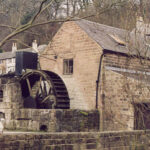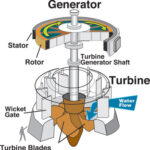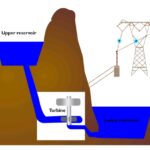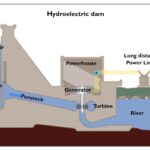 Hydro-Power or hydroelectricity is the term use to referring the production of electrical power through the use of the gravitational force of falling or flowing water.
Hydro-Power or hydroelectricity is the term use to referring the production of electrical power through the use of the gravitational force of falling or flowing water.
The use of water to generate energy is not new. The ancient Greeks invented the water wheel and were the first to use it for both irrigation and as a power source
A water wheel is thus a machine for converting the energy of free-flowing or falling water into useful forms of power.
A water wheel consists of a large wooden or metal wheel, with a number of blades or buckets arranged on the outside rim forming the driving surface.
 Their main shortcoming of a water wheel is size.
Their main shortcoming of a water wheel is size.
The migration from water wheels to modern turbines took about one hundred years.
Today hydro-power generation is big business. In fact, it is the best established form of renewable electricity production in the world.
Currently hydroelectricity power stations produces about 20% of all global electricity production.
Just like water wheels the modern turbine is rotated by water. The turbine spins the generator that produces electricity. Also see the article; what is electricity on this website.
Water turbines were developed in the 19th century and were widely used for industrial power prior to electrical grids. Now they are mostly used for electric power generation that feed the national electric grids.
It is estimated that the building of hydroelectric dams will world-wide increase by about 50% in the next 20 years.
Pumped water reservoirs for generating electric power also fall in this same category.
This is where water is pumped to high ground (top of a mountain), typically by wind or solar during sunny and windy times. The “energy” is thus stored in the upper reservoir in the way of water.

During pick times when people and industries need more electricity the water gates are opened and the water flows down the mountain through a turbine. The turbine spins a generator that generates powers to the grid.
The lower reservoir fills up and the water is pump back to the upper reservoir to minimise water wastage. This is s great way to store energy.



